Joe Lanni’s boatbuilding journey began in 2020 when he built 3’S A CROWD, a sectional rowing and sailing skiff designed by Ken Simpson. Two years later, in search of something “more boatlike…a composition of curves flowing into one another,” he built David Beede’s Wackless Lassie, based on Fritz Funk’s Wacky Lassie. Still a boat of relatively simple construction—hard chine, flat bottom, sheet-plywood sides and bottom—the Wackless Lassie had enough curve and subtle sheer to satisfy Joe’s aesthetic leanings. But even as he christened it PARTY OF ONE, Joe was already musing about his next boat: “probably something larger and with, perhaps, even more curves.”
In 2023, Joe did, indeed, launch his third boat, a Puddle Duck Racer. “The complete opposite of a boat with nice lines and curves,” admits Joe. “It is quite literally a box.”
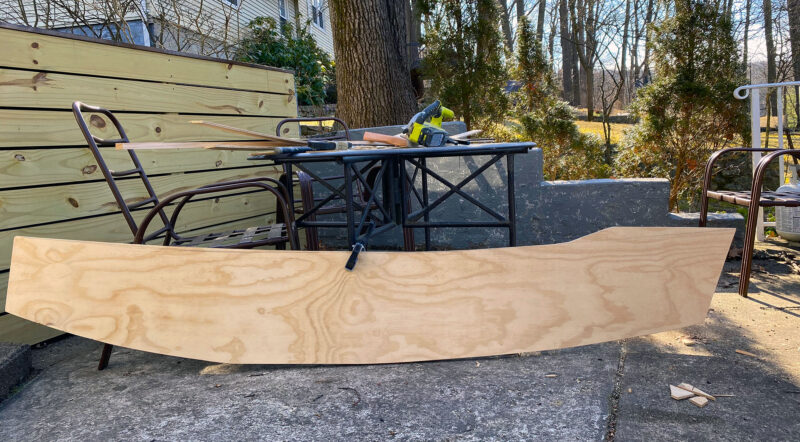 Joe Lanni
Joe LanniJoe made the parts for the hull inside over the winter then brought them out into the spring light for assembly. The side panel clearly shows the boat’s profile. The curve of the bottom is required for racing Puddle Duck Racers.
But Joe describes himself as the perpetual novice and, despite his appreciation for more complex hull designs, and his proud admission that his skills are “much improved,” he didn’t feel he was quite ready to “build a more complicated type of sailboat.”
There were no boats in Joe’s early life, nor even any woodworking experience. He watched his father work on carpentry projects in the house but never got to help. But he has always loved boats and has always been good with his hands—today he is a middle-school art teacher. He is also, by his own admission, addicted to small wooden boats. “I can’t stop looking at Small Boats and WoodenBoat. I dream of all the boats I would like to make and use. If I had better woodworking skills, my addiction would be much easier to take.”
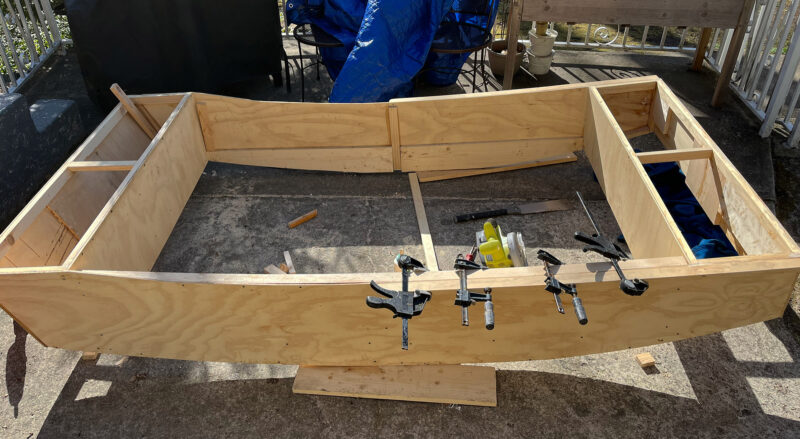 Joe Lanni
Joe LanniThe boat comes together. The bow and stern are similar in profile although there is a little more height in the bow, seen here to the left. Toward the stern, Joe added some 1 x 2″ pine to strengthen the sheer and provide a modicum of comfort when sitting on the windward rail.
The Puddle Duck Racer was the brainchild of David “Shorty” Routh, who devised the class in 2003 so that amateur boatbuilders could get out on the water, easily and cheaply. Shorty enjoyed building boats, messing about in boats, and racing boats. But when he realized there was no club that catered to and encouraged all three, he established his own and created the 8′-LOA Puddle Duck Racer as the club boat.
There were simple rules: all Puddle Duck Racers must have the same shape for the hull’s flat parallel sides; all must be at least 48″ wide across the bottom; all must have enough emergency flotation to be self-rescuing. Today’s class rules are even simpler: the bottom 10″ of every boat must be identical. But, says Shorty, “it’s not about the limitations of the rules, it’s about the creativity of everything else.”
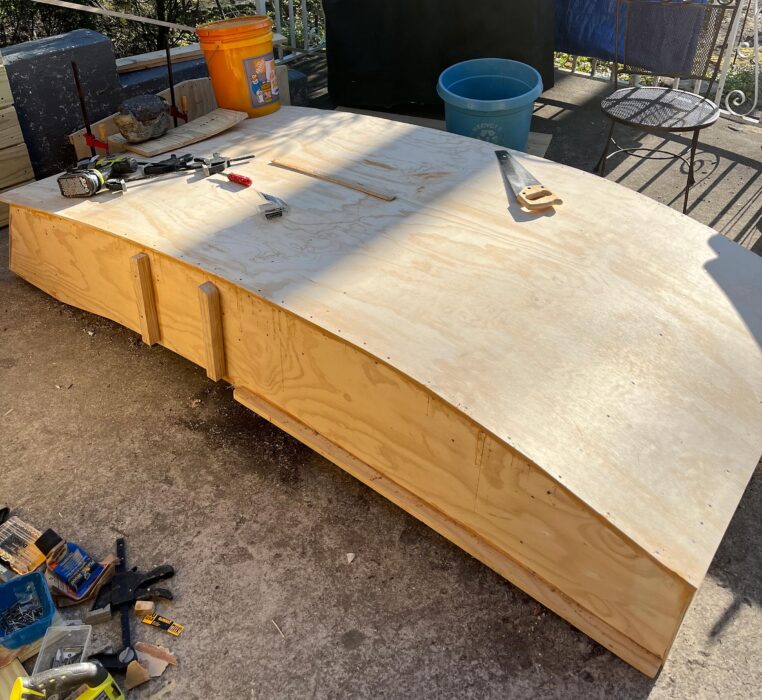 Joe Lanni
Joe LanniOnce the boat was fully framed up, Joe turned it upside down and attached the bottom panel—a single sheet of 3⁄8″ plywood. The two vertical struts on the starboard side are for the leeboard.
Joe came across the Puddle Duck Racers during his many wanderings down the rabbit holes of the internet. “They kept popping up,” he says. “I kept reading how surprised people were by how well the boat actually sails, despite being so easy to build.”
At the time, Joe had an old Styrofoam Snark sailboat that had become waterlogged and very heavy. When he saw an image of a Puddle Duck Racer rigged with the instantly recognizable lateen sail of a Snark, he saw his way forward: he could save the usable parts of his old Snark to outfit a new Puddle Duck. He was also drawn to the affordability: “The plans were free; the materials were cheap. I could use my Snark sail and modify the daggerboard—it would be perfect.”
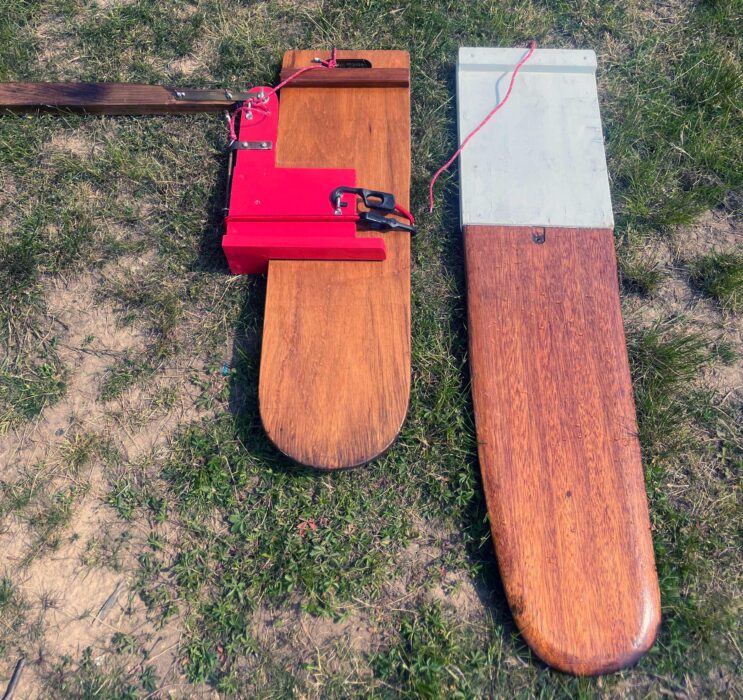 Joe Lanni
Joe LanniJoe used a Snark ‘s daggerboard for the rudder’s blade and a Sunfish’s daggerboard for the leeboard for his PDR. The latter was too short so Joe extended it with a piece of pine sandwiched between two pieces of overlapping plywood.
One aspect that attracted Joe to the Puddle Duck Racer was the “encouragement of creativity. The bottom 10″ have to follow the plan, but above that anything goes, and people have introduced a variety of rigs and styles.” The most obvious element of variation is in the flotation. “Shorty Routh considered safety and encouraged the building of airboxes. Some builders have made them lengthwise on either side, others, like me, have placed them in the ends, where they take up less of the cockpit area.” As it says on the Puddle Duck Racer website, with the end airboxes there is “a lot of interior room for passengers, drink cooler, and your dog.” Also, by placing the buoyancy tanks in the ends the skipper is encouraged to sit farther forward, which in turn balances the boat, and the forward tank keeps the boat a little dryer when sailing into a chop. For Joe, there was no doubt, end airboxes were the way to go. He downloaded the plans and building instructions for Jim Michalak’s Catbox design.
Over the winter of 2022–23, Joe built the boat’s parts in his basement. “I used three sheets of exterior-grade plywood, 1⁄4″ for everything except the bottom, which is 3⁄8″.” He started by sketching all the parts full-size on paper. “I taped the paper sheets together and then transferred the drawing to the plywood sheets.” For the framing he used 1 × 2″ pine and, to strengthen the bottom, he would add longitudinal pieces of 1 × 6″ pine. By spring everything was ready for assembly and Joe moved the project outside.
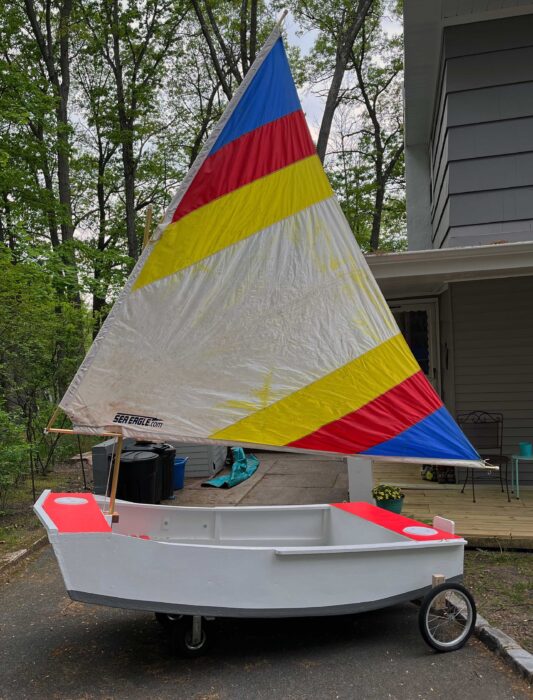 Joe Lanni
Joe LanniReady to go: LUCKY DUCK sits on her home-made launching trolly. In the stern, Joe used small bicycle wheels, while beneath the bow are smaller dolly wheels, which Joe says are not large enough and will be replaced.
“Always looking for ways to keep the costs down—I have a patient wife who allows me the time to build but did not want me to spend a lot—I decided against using epoxy and fiberglass,” he says. “Instead, I used the same method I used on my two earlier boats: stainless-steel screws, Titebond III waterproof glue, and FibaTape, a self-adhesive fiberglass-mesh tape used by dry wallers.” Titebond is typically used for non-structural joints but, Joe says, when combined with the tape, it “forms a rock-hard seal on the outside edges, which has held up well on my other builds.”
Joe painted the sides of the boat with latex house paint and finished the interior and bottom with exterior porch floor paint. “I didn’t ’glass the bottom,” he says, “because I wanted to keep the expense down until I was sure I liked the boat. Of course, now I wish I had.”
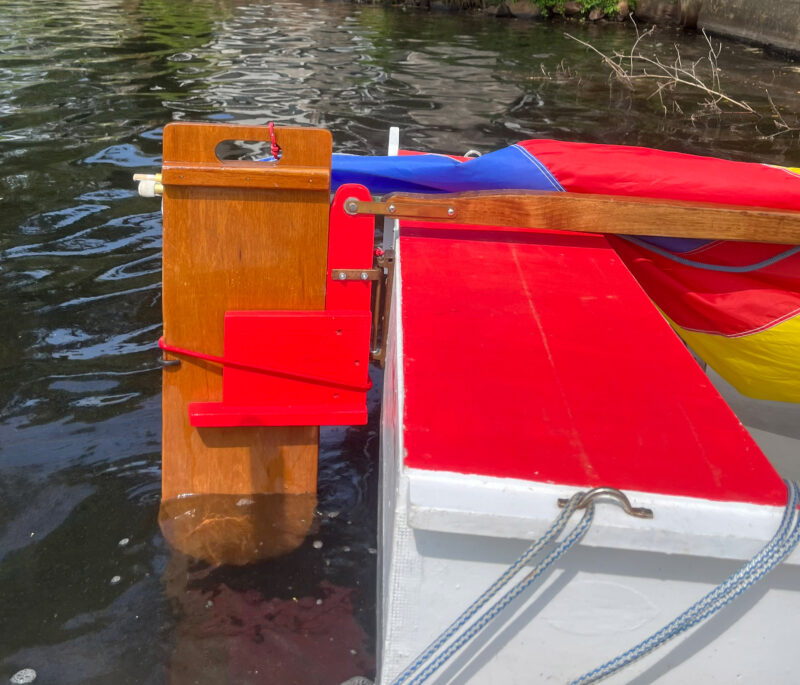 Joe Lanni
Joe LanniThe old Snark daggerboard was repurposed as LUCKY DUCK’s rudder blade. Joe made a pine frame resembling rudder cheeks, to which he attached the tiller, and which holds the lifting blade in position, down or up, by a single bungee in tension.
With construction complete, Joe turned his attention to the rig. The sail and spars came from the Snark, but he decided to use the Snark’s daggerboard as his new rudderblade. He fitted it in a pine-framed slot and made the tiller from a single piece of knot-free pine, “stained to look like a more expensive piece of hardwood.” The leeboard was fashioned from a daggerboard reclaimed from an old Sunfish. “It wasn’t long enough so I extended it with a piece of 3⁄4″ pine sandwiched between two pieces of plywood that overlapped the bright-finished board.” He attached some leftover 1×2s to either side of the sheer for strength, to provide some protection for the sides of the boat, and to make a more comfortable perch for the skipper should they wish to sit up to windward. Finally, he made a transom-mounted bracket for a Minn Kota electric trolling motor, and a launching trolley fashioned out of 2×4s and reclaimed bicycle and dolly wheels.
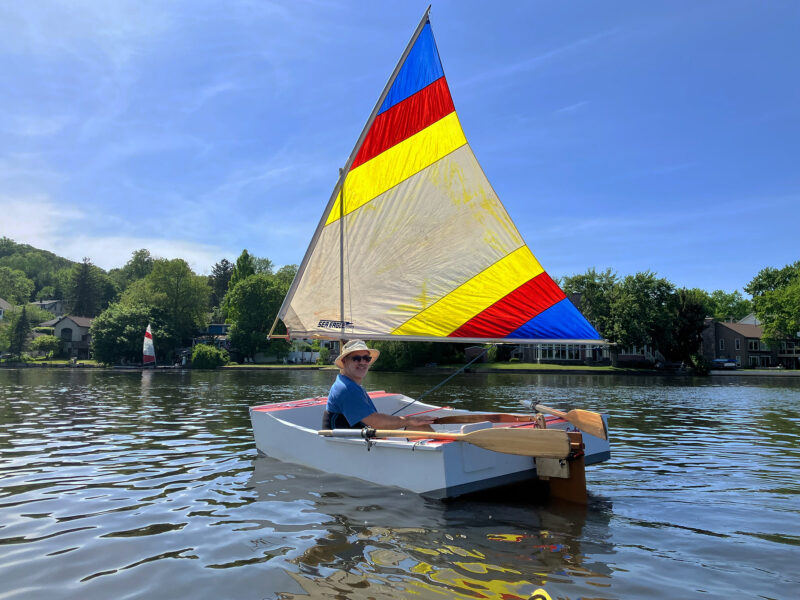 Ruthann Lanni
Ruthann LanniThe Snark lateen rig fits LUCKY DUCK well, with its boom set high to make changing sides easier when coming about. Kept in place by their oarlocks, the oars are out of the way while sailing yet instantly ready when needed.
LUCKY DUCK was launched and christened in May 2023, and Joe sailed her all summer long. “My hull is #1108. It says a lot that more than a thousand of these little boats have been built. I read somewhere that there’s no good reason a boat that looks like this should sail as well as it does, and I have to agree, it does sail really well, and it feels super big for such a small boat. I can take my 13-year-old daughter and 11-year-old son for rides, one at a time; it’s pretty comfortable. And it’s standing up well: I’ve dragged it, banged it, bunked it, left it in the rain, and it’s going strong.”
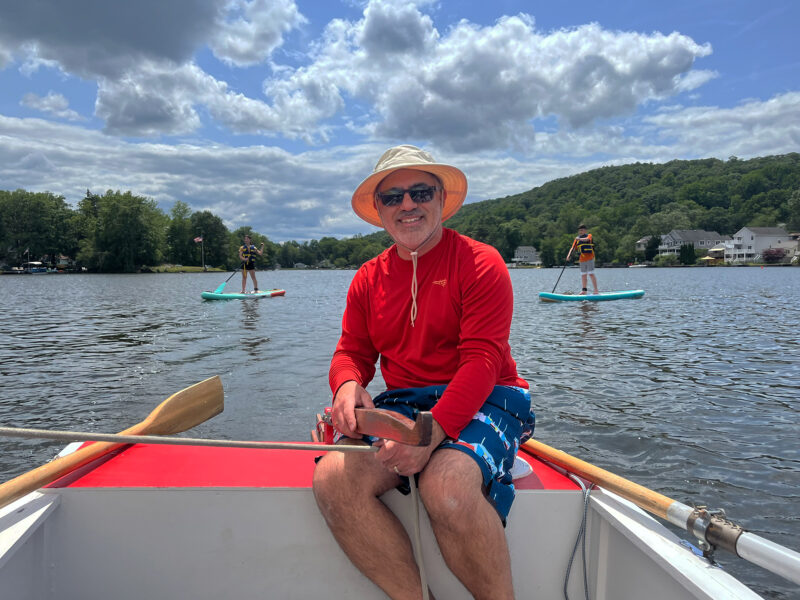 Ruthann Lanni
Ruthann LanniThe stern flotation compartment doubles as a seat for the skipper although when performance demands it, Joe moves forward to sit in the cockpit.
For this year, it seems, Joe’s small-boat addiction has been fed. But there will come a time, he knows, when the rabbit holes will get the better of him, and he’ll be pulled into a new boatbuilding project. Maybe next time, he’ll trust his abilities and go for that “different type of sailboat…a larger one, with more curves.”![]()
Jenny Bennett is managing editor of Small Boats.
Do you have a boat with an interesting story? Please email us. We’d like to hear about it and share it with other Small Boats readers.
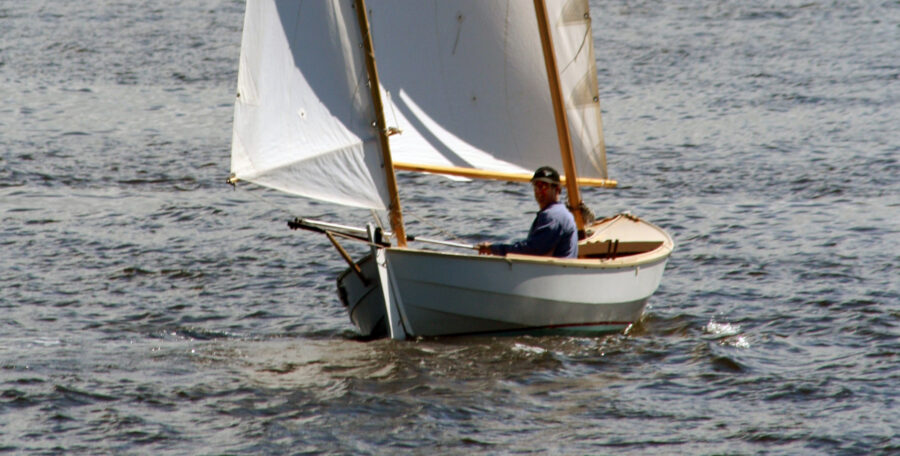
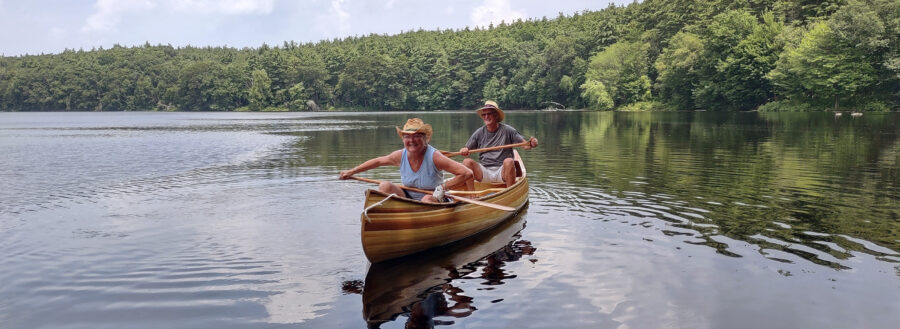
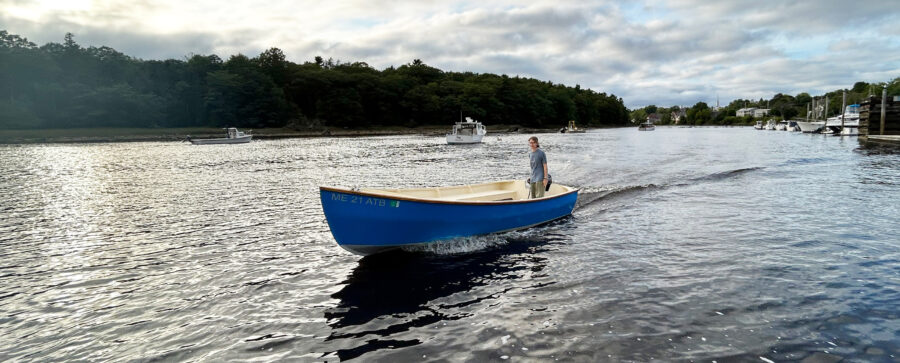
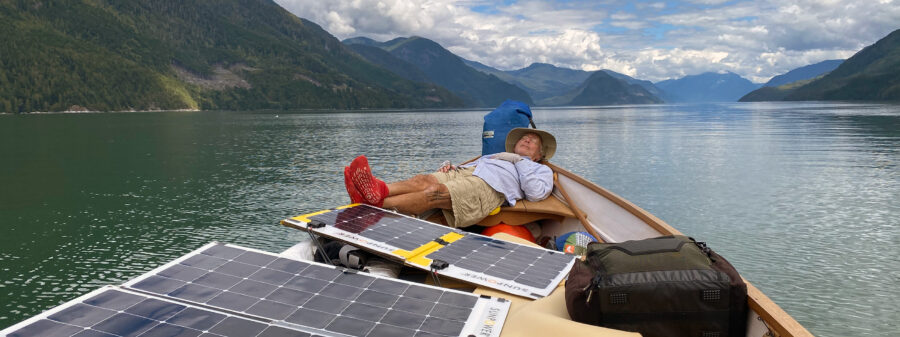

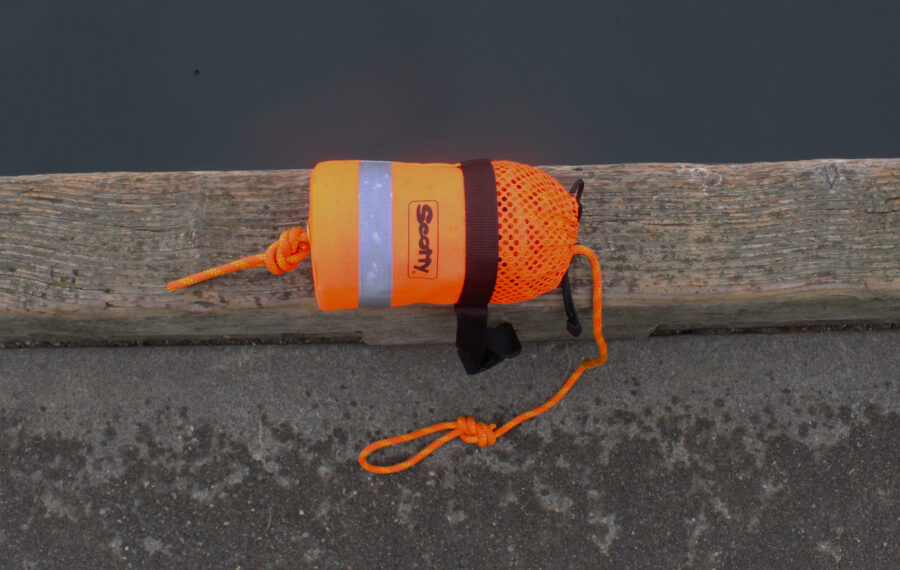
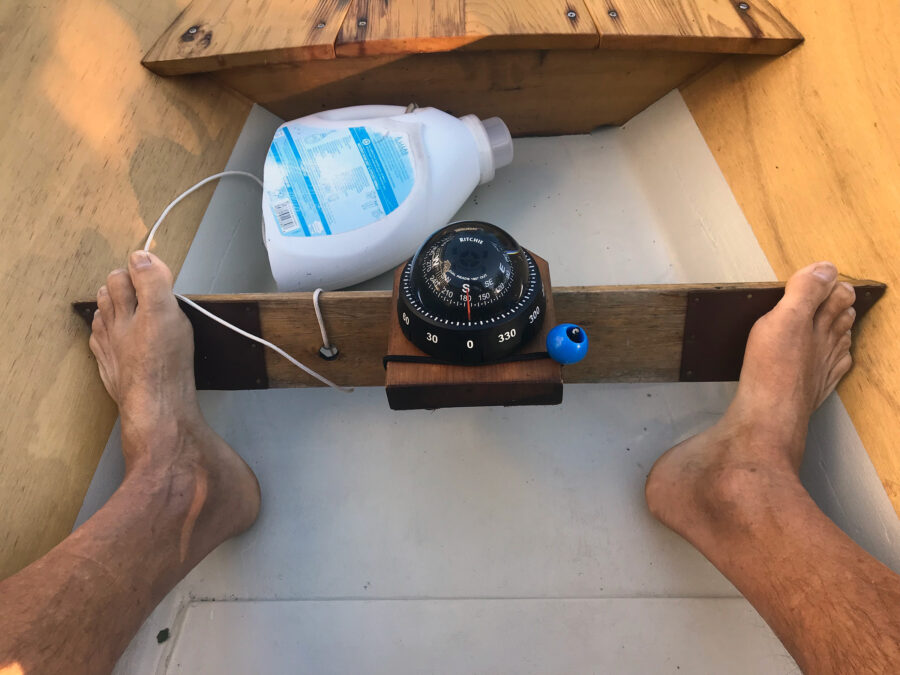
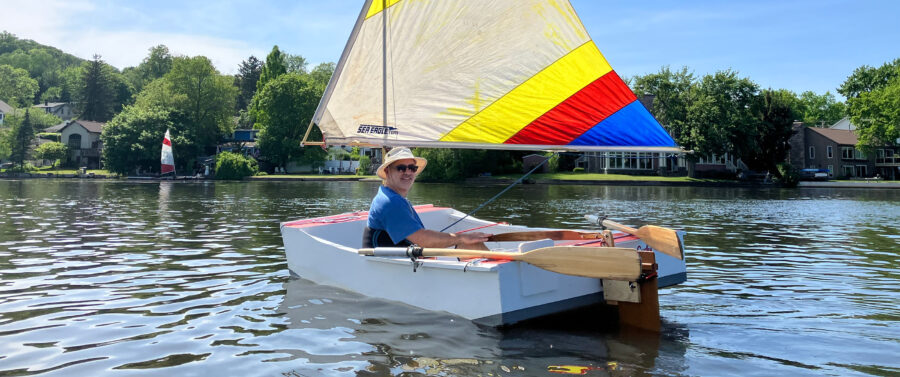
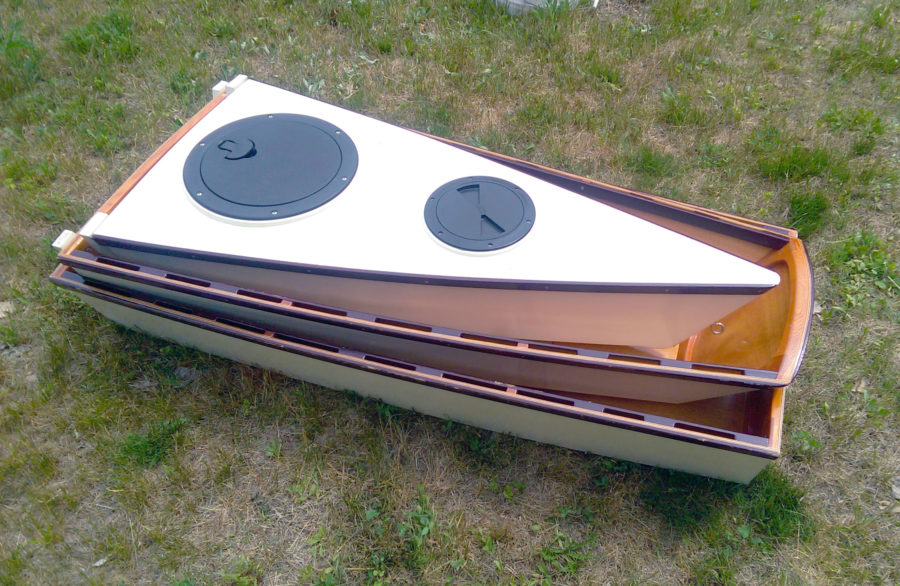
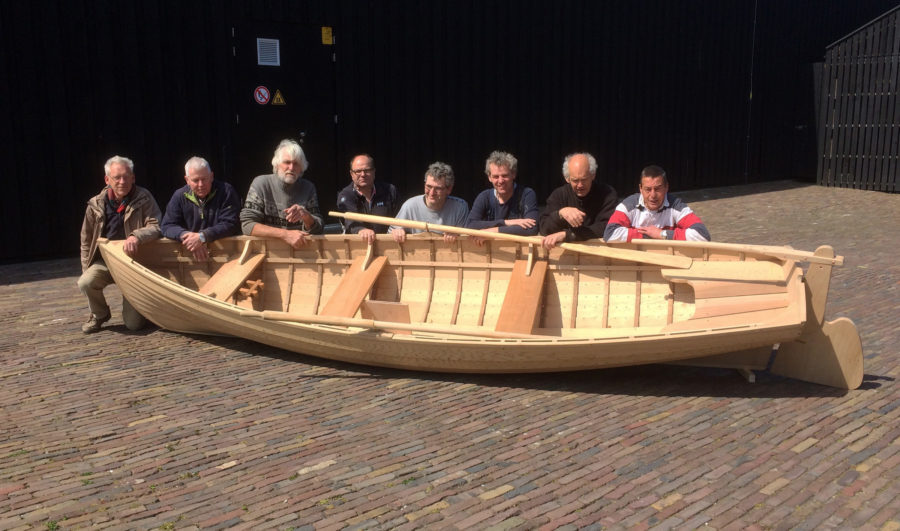
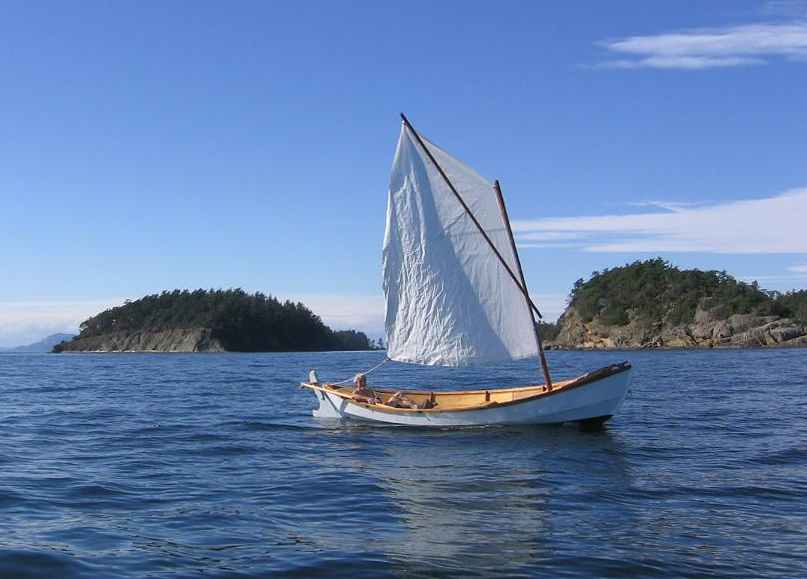
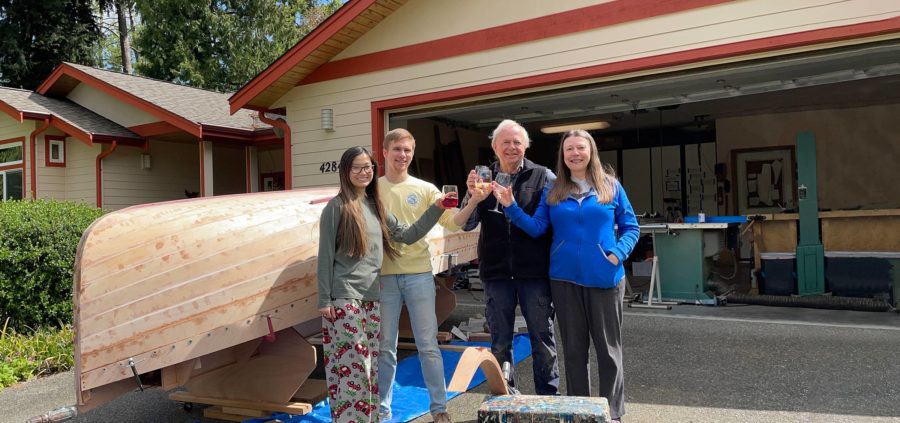
I built my P.D. several years ago but have not sailed it yet. The reason for this is that the boat is so much fun with oars and electric motor that I have not finished my rig. The mast and spar are complete. I need to fabricate the sail, rudder, and leeboard. The boat is easy to build and fun to use. It is adaptable for a lot of uses and would make an excellent first-time or group build. Yeah, it’s a box, but beauty is not everything.
Our Sea Scouts want to build a working replica of a San Francisco scow schooner, around 15′, to keep this local type of vessel alive and because (I think!) it might be a relatively easy build for first timers. She must be lightweight, have a pram bow, flat bottom (the point of the design to allow sailing in shallow creeks), centerboard, 2 masts, and bowsprit for jib. Sailing only in sheltered waters. Any thoughts on adapting this design, or other ideas? We can build; we just need plans.